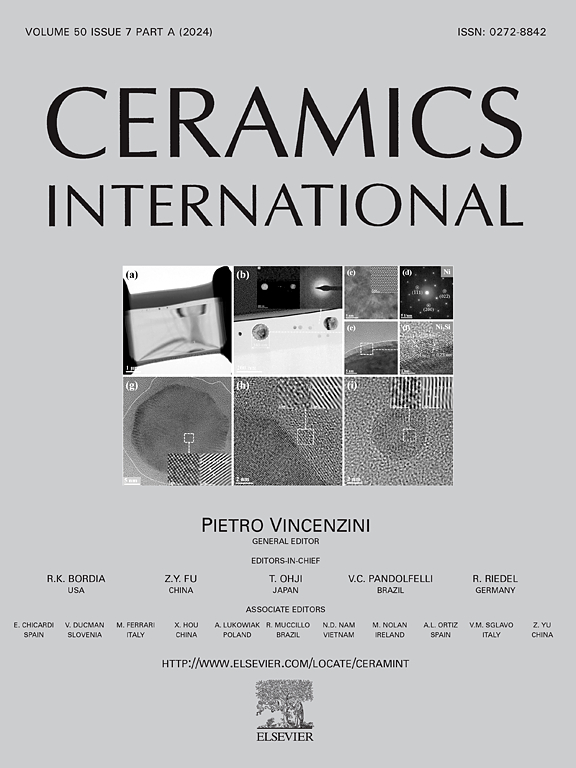The fabrication and insulation performance of TiO2 coating with reticulated porous structure for HTS magnet coils
IF 5.1
2区 材料科学
Q1 MATERIALS SCIENCE, CERAMICS
引用次数: 0
Abstract
Titanium dioxide (TiO2) ceramic coating, characterized by high thermal conductivity and remarkable chemical stability, leading to extensive application in providing electrical insulation within superconducting coils. However, the development of such ceramic insulation coatings to facilitate the preparation of high-performance superconducting magnets is extremely challenging, due to the complex heat treatment process of bismuth system high temperature superconductivity (HTS) wires. A novel strategy for fabricating a porous TiO2 insulation layer with a three-dimensional (3D) reticular architecture based on highly dispersed ceramic slurry has been reported herein. To enhance the structural strength and oxygen permeability of the coating, polyethylene glycol and oligomeric ethyl silicate were introduced as modifiers to construct a grid-like porous framework. The as-prepared insulation coating possesses micron-sized pore and crack structures. The high-temperature stability of the insulation layer and its compatibility with the heat treatment of Ag-sheathed Bi-2223 wire was verified by measuring the effect of coating on the critical current. X-ray photoelectron spectroscopy (XPS) and energy-dispersive X-ray spectroscopy (EDS) show that this insulation coating with a thickness of approximately 25 μm can significantly inhibit the diffusion of metal sheath components and Bi. In addition, the TiO2 insulation coating has also been successfully prepared on Bi-2223 tape by a reel-to-reel coating system. The results indicates that the TiO2 insulation coating has great application potential as an insulation material for HTS magnets and provides new insights for the development of effective insulation material for Bi-2212 wires.

高温超导线圈用网状多孔结构TiO2涂层的制备及其绝缘性能研究
二氧化钛(TiO2)陶瓷涂层具有高导热性和优异的化学稳定性,广泛应用于超导线圈的电绝缘。然而,由于铋系高温超导(HTS)导线的复杂热处理工艺,开发这种陶瓷绝缘涂层以促进高性能超导磁体的制备是极具挑战性的。本文报道了一种基于高分散陶瓷浆料制备具有三维网状结构的多孔TiO2保温层的新策略。为了提高涂层的结构强度和透气性,引入聚乙二醇和低聚硅酸乙酯作为改性剂,构建网格状多孔框架。所制备的绝缘涂层具有微米级的孔隙和裂纹结构。通过测量涂层对临界电流的影响,验证了绝缘层的高温稳定性及其与镀银Bi-2223导线热处理的相容性。x射线光电子能谱(XPS)和能量色散x射线能谱(EDS)分析表明,这种厚度约为25 μm的绝缘涂层可以显著抑制金属护套成分和Bi的扩散。此外,采用卷对卷涂覆系统在Bi-2223胶带上成功制备了TiO2绝缘涂层。结果表明,TiO2绝缘涂层作为高温超导磁体的绝缘材料具有很大的应用潜力,为Bi-2212导线有效绝缘材料的开发提供了新的思路。
本文章由计算机程序翻译,如有差异,请以英文原文为准。
求助全文
约1分钟内获得全文
求助全文
来源期刊

Ceramics International
工程技术-材料科学:硅酸盐
CiteScore
9.40
自引率
15.40%
发文量
4558
审稿时长
25 days
期刊介绍:
Ceramics International covers the science of advanced ceramic materials. The journal encourages contributions that demonstrate how an understanding of the basic chemical and physical phenomena may direct materials design and stimulate ideas for new or improved processing techniques, in order to obtain materials with desired structural features and properties.
Ceramics International covers oxide and non-oxide ceramics, functional glasses, glass ceramics, amorphous inorganic non-metallic materials (and their combinations with metal and organic materials), in the form of particulates, dense or porous bodies, thin/thick films and laminated, graded and composite structures. Process related topics such as ceramic-ceramic joints or joining ceramics with dissimilar materials, as well as surface finishing and conditioning are also covered. Besides traditional processing techniques, manufacturing routes of interest include innovative procedures benefiting from externally applied stresses, electromagnetic fields and energetic beams, as well as top-down and self-assembly nanotechnology approaches. In addition, the journal welcomes submissions on bio-inspired and bio-enabled materials designs, experimentally validated multi scale modelling and simulation for materials design, and the use of the most advanced chemical and physical characterization techniques of structure, properties and behaviour.
Technologically relevant low-dimensional systems are a particular focus of Ceramics International. These include 0, 1 and 2-D nanomaterials (also covering CNTs, graphene and related materials, and diamond-like carbons), their nanocomposites, as well as nano-hybrids and hierarchical multifunctional nanostructures that might integrate molecular, biological and electronic components.
 求助内容:
求助内容: 应助结果提醒方式:
应助结果提醒方式:


